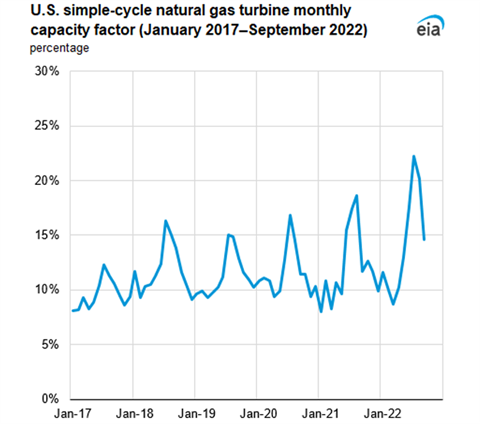Simple cycle turbine plant output continues to rise in U.S.
09 December 2022
Demand grows in part because of increase in renewables

Since 2017, the average monthly capacity factor for simple-cycle natural gas turbine (SCGT) power plants has been rising; the monthly average exceeded 20% for two summer months in 2022, based on data from the U.S. Energy Information Agency’s (EIA) November Electric Power Monthly.
“SCGT power plants typically operate year round but are most active during the summer months (June–August), when electricity demand reaches its peak and varies the most,” according to the EIA. “As a result, simple-cycle plants may operate as much as 20% of the time during the summer. The average monthly capacity factor during the rest of the year falls to around 10% due to lower electricity demand and more consistent electricity output from wind turbines.”
U.S. SCGT operating capacity was 132 861 megawatts (MW) in September 2022, based on our latest Electric Power Monthly. SCGT capacity has been gradually rising since 2020, with an estimated 2121 MW of new capacity entering service in 2021 and another 1196 MW expected in 2022. Close to half of the capacity added in 2021 and 2022 is in Texas, due to its need for more fast-starting generating capacity to meet rising power demand and for greater variability in supply.
SCGT power plants, which burn natural gas in a single turbine to produce electricity, are the second-largest source of natural gas-fired power generation in the United States behind combined-cycle natural gas turbine (CCGT) power plants. SCGT power plants are less efficient and require more fuel per unit of output compared with CCGT power plants because CCGT plants capture excess heat from the combustion process and deliver that heat to a steam turbine to produce additional energy.
The advantage of SCGT power plants for an electric grid operator is that operators can use them to respond quickly to fluctuating demand for electricity. The need for more electricity grid support during the day is growing as a result of larger amounts of wind and solar capacity entering service and the possibilities of constraints in wind or solar output based on daily weather conditions. SCGTs are well suited to provide that grid support because they can produce electricity quickly to immediately fill gaps in electricity output on the grid and then ramp down just as quickly, according to the EIA. Other natural gas-fired electricity generators, such as combined-cycle or steam boiler plants, can take two to three times longer than SCGT power plants to start and ramp-up to full load.
New battery energy storage systems (BESS) may displace some of the generation from SCGT power plants. Currently, 7,115 MW of BESS capacity is in service today, but we expect that capacity to double by September 2023, based on our Electric Power Monthly.
STAY CONNECTED




Receive the information you need when you need it through our world-leading magazines, newsletters and daily briefings.
POWER SOURCING GUIDE
The trusted reference and buyer’s guide for 83 years
The original “desktop search engine,” guiding nearly 10,000 users in more than 90 countries it is the primary reference for specifications and details on all the components that go into engine systems.
Visit Now
CONNECT WITH THE TEAM










